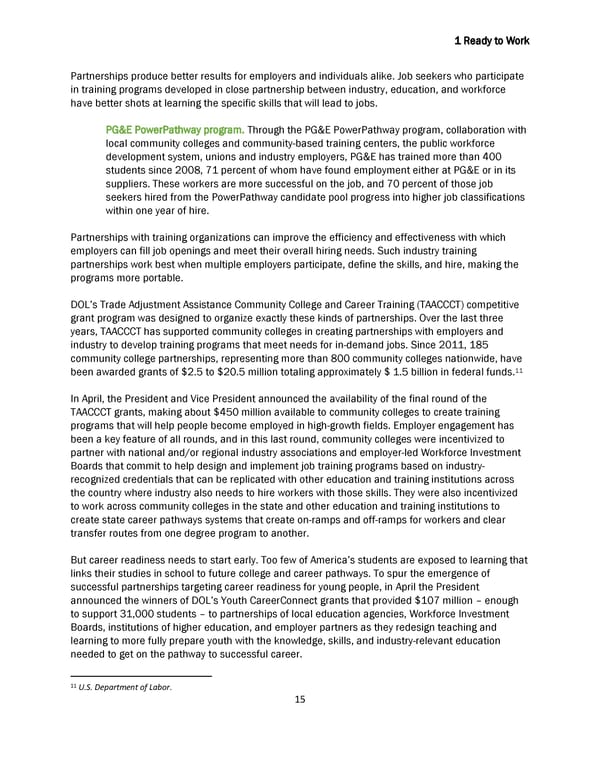1 Ready to Work Partnerships produce better results for employers and individuals alike. Job seekers who participate in training programs developed in close partnership between industry, education, and workforce have better shots at learning the specific skills that will lead to jobs. PG&E PowerPathway program. Through the PG&E PowerPathway program, collaboration with local community colleges and community-based training centers, the public workforce development system, unions and industry employers, PG&E has trained more than 400 students since 2008, 71 percent of whom have found employment either at PG&E or in its suppliers. These workers are more successful on the job, and 70 percent of those job seekers hired from the PowerPathway candidate pool progress into higher job classifications within one year of hire. Partnerships with training organizations can improve the efficiency and effectiveness with which employers can fill job openings and meet their overall hiring needs. Such industry training partnerships work best when multiple employers participate, define the skills, and hire, making the programs more portable. DOL’s Trade Adjustment Assistance Community College and Career Training (TAACCCT) competitive grant program was designed to organize exactly these kinds of partnerships. Over the last three years, TAACCCT has supported community colleges in creating partnerships with employers and industry to develop training programs that meet needs for in-demand jobs. Since 2011, 185 community college partnerships, representing more than 800 community colleges nationwide, have 11 been awarded grants of $2.5 to $20.5 million totaling approximately $ 1.5 billion in federal funds. In April, the President and Vice President announced the availability of the final round of the TAACCCT grants, making about $450 million available to community colleges to create training programs that will help people become employed in high-growth fields. Employer engagement has been a key feature of all rounds, and in this last round, community colleges were incentivized to partner with national and/or regional industry associations and employer-led Workforce Investment Boards that commit to help design and implement job training programs based on industry- recognized credentials that can be replicated with other education and training institutions across the country where industry also needs to hire workers with those skills. They were also incentivized to work across community colleges in the state and other education and training institutions to create state career pathways systems that create on-ramps and off-ramps for workers and clear transfer routes from one degree program to another. But career readiness needs to start early. Too few of America’s students are exposed to learning that links their studies in school to future college and career pathways. To spur the emergence of successful partnerships targeting career readiness for young people, in April the President announced the winners of DOL’s Youth CareerConnect grants that provided $107 million – enough to support 31,000 students – to partnerships of local education agencies, Workforce Investment Boards, institutions of higher education, and employer partners as they redesign teaching and learning to more fully prepare youth with the knowledge, skills, and industry-relevant education needed to get on the pathway to successful career. 11 U.S. Department of Labor. 15
 Biden Ready to Work White Paper 7/22/14 Page 14 Page 16
Biden Ready to Work White Paper 7/22/14 Page 14 Page 16